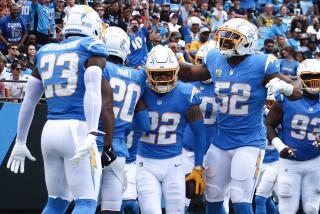Back in charge
As I sit here now I can’t recall his name, the young, unhappy Marine who lived in a clapboard house we rented on our property back home in North Carolina. I remember that when he was off-duty, he wore an unconvincing wig of long blond hair because in 1970 -- a year made deeply dysfunctional by Vietnam -- the jarhead’s brush cut was an insurmountable obstacle to dating. Being 10 years old at the time, I didn’t know what a rough-trade transvestite was, but I knew he looked like one. Poor guy.
His one pleasure was his car, which I remember so vividly that, even now, I could change the air filter with my eyes closed: an orange 1969 Dodge Charger SuperBee with a 440-cubic-inch engine, three two-barrel Holley carbs -- a Six Pack -- on an Edelbrock Hi-Riser manifold, and a four-speed Hurst shifter with an aluminum T-handle that felt like pewter. The Mona Lisa of muscle cars; the highest, most grandiose expression of the Mopar’s mouth-breaking art.
For the record:
12:00 a.m. July 1, 2005 For The Record
Los Angeles Times Friday July 01, 2005 Home Edition Main News Part A Page 2 National Desk 1 inches; 41 words Type of Material: Correction
Car review -- A review of the 2006 Dodge Charger in Wednesday’s Highway 1 section referred to a 1969 Dodge Charger with the Super Bee option package. The Super Bee package was offered on the Charger only in model year 1971.
For The Record
Los Angeles Times Wednesday July 06, 2005 Home Edition Highway 1 Part G Page 2 Features Desk 1 inches; 41 words Type of Material: Correction
Charger review -- A review of the 2006 Dodge Charger in last Wednesday’s Highway 1 section referred to a 1969 Charger with the Super Bee option package. The Super Bee package was offered on the Charger only in model year 1971.
It was a hardtop coupe, with the big rally stripe banded around the tail, Cragar chrome wheels and sheet metal scallops just behind the doors. The lift-off hood was matte-black fiberglass and was held on with four NASCAR-style hood pins. Most days the hood was leaned up against a loblolly pine and the Marine was upended, grimly working on the engine, with only a can of Schlitz keeping him company.
He’d make his shakedown passes at night on Racetrack Road, a pinched, pine-ribbed piece of blacktop a couple of miles from our house. With the windows all open, we could hear the car howling through the woods, or was it him?
I felt the rattle of that car in my chest. I begged for a ride. One summer day, he obliged. We drove to the drag strip in Havelock -- in those days, no one would have thought twice about a 10-year-old boy going off alone with a wig-wearing Marine, though they probably should have.
Most of the time, the car had a thudding, arrhythmic idle caused by the hot cam, a sound like rubber hammers tumbling in a dryer. The Six Pack used only the center carb for normal driving, which was its only concession to fuel economy. But in the burnout box, he gassed it and all three carbs dumped a whirlpool of 101 Octane into the Edelbrock’s gullet. Oh ... my ... God! The hood shook, the engine twisted so hard in its cradle that it seemed the car was going to flip on its side, and the Glasspack Cherry Bomb mufflers blew like Gabriel’s horn. I pulled on the loose end of the lap belt as hard as I could.
All things considered, the next 11 seconds were the most important in my life.
So that’s my Dodge Charger story. A lot of people have them: the black Charger that the bad guys drove in the Steve McQueen movie “Bullitt,” the orange Charger that the Duke boys drove in Hazzard County.
And then it all went horribly wrong. Charger is one of the most traduced names in automotive history. By the late 1970s the name was stuck on a Chrysler Cordoba clone; in the ‘80s it was affixed to a version of the Dodge Omni. Bo Duke, a nation turns its lonely eyes to you.
Please, no, not again
WHEN Dodge announced last year it was going to revive the Charger name after nearly two decades and stick it on a four-door platform sibling of the Dodge Magnum wagon, it seemed to me like more of the same. Muscle car geezers were at the time accusing Pontiac of sacrilege for affixing the GTO name to a reskinned Holden Monaro, and I considered writing an article calling for some car names to be retired, hung from the rafters like pro ballplayers’ numbered jerseys. At long last, senator, have you no sense of decency?
Now, I’m not so sure. True, the new Dodge Charger looks nothing like the car of 35 summers past. It’s a big sedan wrapped in sleeve-splitting sheet metal, a kind of thick, high-sided maximalism that looks nothing like the stiletto lines of the Charger coupe I knew. Anyone suggesting the car has a retro theme has succumbed to Dodge’s powerful psy-ops hallucinogens.
In terms of engineering, the new Charger -- based on a reinvented version of a Mercedes’ E-class chassis, the same that underpins the rear-wheel drive Magnum and the Chrysler 300 -- couldn’t be less like an old Charger if it were made of Wonder Bread.The Charger comes in three flavors: the base SE and mid-level SXT, powered by a 3.5-liter, 250-hp V6; and the R/T, a 5.7-liter V8, the registered-trademark, “it’s-gotta” Hemi engine putting out 340 horsepower and 390 pound-feet of torque. The top-shelf Daytona R/T option bumps up horsepower another 10 with a revised induction and dual exhaust system and wraps it in a garish tape-and-paint package.
The Hemi engine has the company’s cylinder deactivation technology, which cuts out four of eight cylinders when engine loads are light. Every little bit helps, I suppose. In any event this powertrain -- including the five-speed automatic transmission standard with both engines -- is cleaner, and more efficient and drivable, than anyone in the lead-poisoned ‘60s could have imagined.
Smooth and supple, with a vacuum-packed solidity that forbids rattles and squeaks, the car has a light, predictable feel with great grip for a 2-ton car and surprisingly civil cornering behavior. I drove the R/T edition, which includes firmer suspension, stickier 18-inch tires and the 340-hp Hemi engine. These are big, horsy numbers and you might reasonably expect a little muscle car shake and burn. But the Hemi goes about its business so smoothly it feels like it’s hardly running. The 440 I knew sounded like it was going to go China syndrome at idle, and things got increasingly dicey from there. The old cars were known for even conking out at full throttle, literally drowning in raw gas.
A tighter ride
IT’S not that the R/T has such high performance values, but that the car is so well tempered when driven hard. The firmer suspension restrains weight transfer and body roll in corners. While it’s no sports car, it works like a charm. The old, cult figure Charger that inspires such logy devotion was a rattling, road-wandering wreck, with extremely well-rounded dynamics in the sense that it could neither turn nor stop. For a clinic on how to drive one of these bricks fast, rent “Bullitt.”
And yet, something feels familiar -- an audacity, perhaps. For one thing, this is a big car -- 200.1 inches long, about a foot longer than segment rivals Mustang and GTO. For another, it has a common-man simplicity in the cabin, like the old cars, which were, considering their performance, pretty inexpensive. The new Charger is straight-ahead, old-school interior design: big white gauges, rotary-knob climate controls and a straightforward audio stack -- no theatrical pin spots of accent lighting, no controls on the steering wheel. It’s a little spare for me, but I appreciate the restraint.
I think I’m going to change my mind. I used to think the recycling of grand old names from automotive history was cynical and inauthentic, a marketing bid to make people forget the anemia of the present with memories of a full-blooded past. Now, I wonder, what’s the harm? The new Charger makes it easy to forgive and forget those cars unworthy of the name.
*
(BEGIN TEXT OF INFOBOX)
2006 Dodge Charger R/T
Base price: $29,995, plus $675 destination fee
Price, as tested: $33,645
Powertrain: 5.7-liter overhead valve V8, variable displacement, five-speed automatic transmission, rear-wheel drive
Horsepower: 340 at 5,000 rpm
Torque: 390 pound-feet at 4,000 rpm
Curb weight: 4,031
0-60 mph: 6 seconds
Wheelbase: 120.0 inches
Overall length: 200.1 inches
EPA fuel economy: 17 miles per gallon city, 25 highway
Final thoughts: A current affair
Contact automotive critic Dan Neil at dan.neil@latimes.com.






